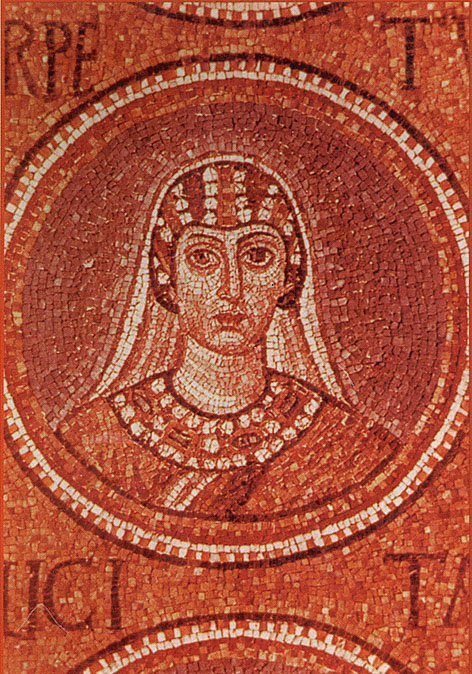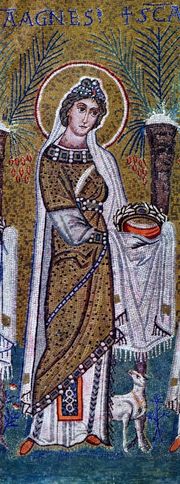 |
|
|
|
| Class
Prep |
|
|
|
Dying
for a Life: Martyrdom & Gender 
- Early Christian martyrs like Perpetua, pictured to the right, enjoyed
such profound respect in early Christianity that they were often venerated. It
was common for locals and pilgrims alike to gather at the graves of the martyrs
on the anniversaries of their deaths to commemorate the ultimate witness they
had given to their faith in Christ (the Greek word, martyr, means "witness").
During these memorial celebrations, an account of the martyrdom would be read,
and many of these accounts have survived to our day.
-
- Our first primary
reading selection for today is one of the earliest examples of a woman's martyrology.
It comes from The Martyrdom of Perpetua and Felicitas, an account of a
North African women Vibia Perpetua and her slave Felicitas, who were killed by
the Romans in 203 CE. As you read the primary
reading, Gail Corrington Streete's essay in WCO, and Chris Frilingos' essay
on Camino, consider the following:
-
-
- How is Jesus' martyrdom and future triumph (as the Lamb) gendered in the Book of Revelation (Frilingos)?
- What do you make
of the tension Perpetua reports between her father and herself? What
does it demonstrate?
- Make a list of the occasions in the text when
Perpetua or Felicitas are described in terms of their bodies. How do
they manifest their concern for the spiritual world in relation to their bodies?
- In what ways do Perpetua and Felicitas go to their deaths as women? as
men?
- Who is more heroic, the martyred man or the martyred woman?
-

- The second and third primary reading selections for today continue the theme
of martyrdom, only both of these accounts were written well after the threat of
persecution had passed. Both focus on one particular martyr, Agnes,
pictured to the left. As the story goes, she was one of many Romans martyred during
the empire-wide persecutions of Emperor Diocletian that took place from 303-305
C.E., just before Constantine legalized Christianity with the Edict of Milan (313
C.E.) Historical evidence of her martyrdom is weak, but that didn't stop fourth
and fifth century authors from using her as a model for Christian women.
-
- In
the first account, the great Bishop Ambrose of Milan uses the tale of Agnes' martyrdom
to encourage his sister Marcellina in her chosen life of celibacy (On Virgins,
377 C.E.). Ambrose begins by saying of Agnes, "in virtue, she was above nature."
How does he show that in his account of her death?
-
- In the
second account of Agnes, Prudentius recounts her story a full century after the
legalization of Christianity (The Crowns of Martyrdom). Martyrologies of
women at this later date are infused with sexual innuendo, so much so that some
commentators have referred to these stories as Christian pornography. Why in the
world would authors advocating celibacy use the language of eroticism and sexual
violence to advance their cause?
-
- The student excavator today, if we have one, will focus on Carthage, a city in modern
Tunisia and an important center in the early North African church, where Perpetua and Felicitas were executed. The presentation will focus
less on the city, per se, and more on what we can reconstruct of Roman spectacles
in which conquered peoples and criminals were executed to entertain the crowds.
-
-
- Assigned Readings
-
- Primary: Martyrdom accounts of of Perpetua and Felicitas and Agnes (Camino)
-
- Secondary: Frilingos, "As If Slain," pp. 64-88 in Spectacles of Empire (Camino); WCO 345-54; online class prep
-
- Optional: Revelation 4–6; 17–19; 21:9–22:7
-
- Slides for Lecture
-
-
- Today's Author
-
| |
 |
Christopher Frilingos is an Associate Professor of Religious Studies at Michigan State University. |
| |
 |
Gail Corrington Streete retired in 2011 from her position as W. J. Millard Professor of Religious Studies at Rhodes College in Memphis, Tennessee. |
-
-
- Dig Site 7: Gender & Martyrdom in North Africa (Carthage, Tunisia)
-
-
- Further Reading
-
- Baert, Barbara. "More Than an Image: Agnes of Rome: Virginity and Visual Memory," trans. Irene Schaudies. In More Than a Memory: The Discourse of Martyrdom and the Construction of Christian Identity in the History of Christianity (ed. Johan Leemans; Annua nuntia lovaniensia 51; Dudley, Massachusetts: Peeters, 2005) 139-68.
-
- Brown, Peter R. L. The Body and Society: Men, Women, and Sexual Renunciation in Early Christianity. New York: Columbia University Press, 1988.
-
- Burrus, Virginia. "Dying for a Life:
Martyrdom, Masochism, and Female (Auto)Biography." In The Sex Lives of Saints: An Erotics of Ancient Hagiography (Divinations: Rereading
Late Ancient Religion; Philadelphia: University of Pennsylvania Press, 2004) 53-90,
but especially pages 69-76.
-
- --------. "Reading Agnes:
The Rhetoric of Gender in Ambrose and Prudentius." Journal
of Early Christian Studies 3 (1995) 25-46.
-
- --------. "Spirited
Advocacy: Ambrose of Milan." In "Begotten, Not Made"
Conceiving Manhood in Late Antiquity, Figurae: Reading Medieval Culture 39
(Stanford, California: Stanford University Press, 2000) 134-83, especially 140-52.
-
- Fox, Vivian C. "Historical Perspectives on Violence Against Women." Journal of International Women’s Studies 4:1 (2002) 15-34.
-
- Frank, Georgia. "Macrina's Scar: Homeric Allusion
and Heroic Identity." Journal of Early Christian Studies
8 (2000) 511-30.
-
- Frankfurter, David T. M. "Martyrology and the Prurient Gaze." Journal of Early Christian Studies 17:2 (2009) 215-45.
-
- Gold, Barbara K. Perpetua, Athlete of God, Women in Antiquity. New York: Oxford University Press, 2018.
-
- Hartney, Aideen M. Gruesome Deaths and Celibate Lives: Christian Martyrs and Ascetics. New York: Oxford University Press, 2005.
-
- Krawiek, Rebecca. "'From the Womb
of the Church': Monastic Families." Journal of Early Christian
Studies 11 (2003) 283-307.
-
- Osiek, Carolyn. "Perpetua's
Husband." Journal of Early Christian Studies 10 (2002)
287-90.
-
- Perkins, Judith. "The Rhetoric of the Maternal Body in the Passion of Perpetua." In Mapping Gender in Ancient Religious Discourses(ed. Todd Penner and Caroline Vander Stichele; Biblical Interpretation Series; Boston: Brill, 2007) 313-32.
-
- --------. The Suffering Self: Pain and
Narrative Representation in the Early Christian Era. New York:
Routledge, 1995.
-
- Rives, James. "The Piety of a Persecutor." Journal
of Early Christian Studies 4 (1996) 1-25.
-
- Ross, Jill. "Dynamic
Writing and Martyrs' Bodies in Prudentius' Peristephanon." Journal
of Early Christian Studies 3 (1995) 325-55.
-
- Shaw, Brent D. "Body/Power/Identity:
The Passion of the Martyrs." Journal of Early Christian Studies
4 (1996) 269-312.
-
- Smith, J. Warren. "A Just and Reasonable
Grief: The Death and Function of a Holy Woman in Gregory of Nyssa's Life of
Macrina." Journal of Early Christian Studies 12 (2004)
57-84.
-
-
- Sources
-
- Photographs:
-
- A mosaic medallion of Perpetua from North Africa,
in William Tabbernee, Montanist Inscriptions and Testimonia: Epigraphic Sources
Illustrating the History of Montanism, 112-15 (Macon, GA: Mercer University Press,
1997) Mont 143, reproduced online by B. K. Harvey, "Martyrdom of Perpetua,"
Kent State University, online, http://www.personal.kent.edu/~bkharvey/roman/sources/perpetua.htm, 22 February 2004.
-
- Photograph: From a Mosaic
in a 6th-century Church in Ravenna, Italy, [Sct]A Agnes (sancta, or holy, Agnes),
"Icon of St. Agnes," reproduced on "Holy Women of Orthodoxy,"
online, http://www.geocities.com/orthodox_women/agnes.html,
24 February 2004.
|
|
|
|
|
|
|
